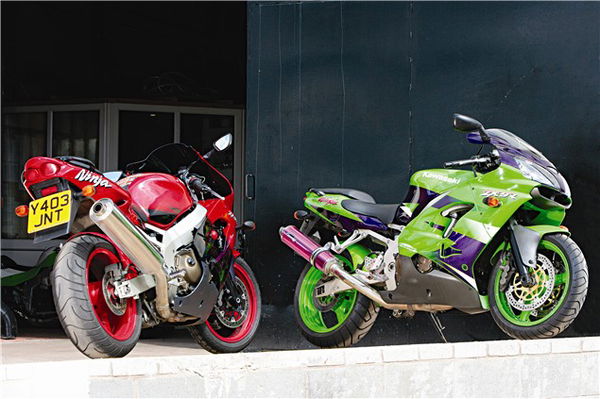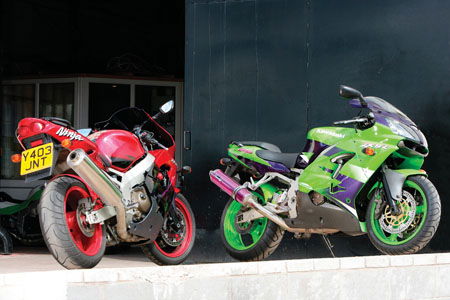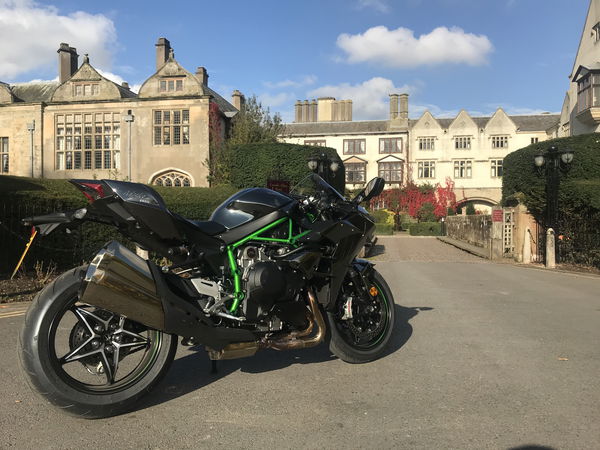Used Review: Kawasaki ZX-9R (B1 - F2P)
Kawasaki built a Blade beater for 1998, just in time for Yamaha's R1 to trump the pair of 'em. But all was not lost - the ZX-9R drew a dedicated following.

|
KAWASAKI'S ZX-9R should always be considered a 'sporty' sports-tourer first and foremost, not a full-on sportsbike aiming to beat Honda's FireBlade or Yamaha's R1.
Once you get this one very important fact straight then you can start to appreciate the machine for what it was and still is: a very fast, well put together motorcycle that's comfy both one- and two-up and available at a price to suit most pockets.
The big K had always had a reputation for making aggressive 900cc bikes, stretching back to the Z1 of 1972, through to the GPz900R of 1984, and they did the business again with the ZX-9R B Ninja in 1994.
Thing was, this was a bit of a flawed gem. It was fast, it was furious but it was also a bit wobbly at the back and a little bit lardy to boot. As far as the back end was concerned there was either nothing wrong at all or the rear shock/linkages and tyre combination were all cock-a-hoop (depending on who you believed), but the fact that it was a bit big and a bit heavy meant that, for many bikers in the UK, it ably filled a gap between the ZXR750 sports tool and the ZZ-R1100 tourer.
Things changed in 1998 as Kawasaki got serious. In came shark-like sleekness, less weight (183kg dry, down from 215) and more power - 143 claimed bhp, a whopping 18bhp increase over the previous model.
It was better than 1998's podgy, soft FireBlade and Kawasaki ruled the litre sportsbike class. But their reign was short-lived - a matter of weeks in fact - as suddenly the Yamaha YZF-R1 came in, tore up the rule-book and bopped the big Ninja on the nose.
But, even compared to the mighty R1, the ZX-9R still had some things going in its favour.
Firstly, it was fast. Like fast as only Kawasaki can do, even outpacing the R1 in some road tests. Then there was the practicality side of things. The 9R seemed to be practical where the R1 wasn't, despite the Kawasaki's lack of bungee points or a fuel light. This was, in reality, a trick of the light, or at least the seat. It had one, where the R1 had a black Brillo pad.
While the R1 and Blade were honed to battle it out as top litre sports tools, the 9R was allowed to mature into a niche bike for those who like a little bit of comfort with their craziness, until being replaced by the bonkers ZX-10R in 2004.
But if you thought the 9R story died with the ZX-10R, think again. With older models now proving to offer an awful lot of metal (and performance) for the money, as well as inspiring many loyal owners' websites, the bike continued to be sold alongside the 10R in 2004. Even now, with a little bit of searching, you can find a zero mile ZX-9R, brand-new for £6200. That's a whole lotta bike considering the last B-model was sold for almost ten grand new.
HEAD BEARINGS
Some owners of the F-model have reported head bearings breaking up early, with replacements fitted under warranty. You'll feel it start as a small click or knock as you apply the brakes or pitch the bike into corners. Make sure the head bearings aren't too tight - a common fault on home-serviced machines of all types
CARBS
Need regular checking to keep them balanced. If you get a Dynojet kit fitted, make sure it's put in by someone who knows what they're doing or you'll be rewarded with a bike that will run rough or won't idle. On some Dynojet kits fitted to C models, little ridges were found on the needles. As they went in and out they would file away at the brass jets and within a few hundred miles create a bigger hole and enrich the mixture. New titanium (not steel) needles fixed the problem. All 9Rs are sensitive to carb set up, so a regular check for crap in the float bowls is essential
FRONT FORKS
Generally a little soft, and after a hard life the oil in 'em can oxidise and turn into a thick gloop which forces its way past the seals
FRONT BRAKES
Never the most powerful. Six-pot Tokicos came into use with later B models, carried through on the C and Es but disappeared on the 2002-on 9Rs, replaced by much better four-potters. They all need regular cleaning, but many owners upgrade to braided hoses and Carbon Lorraine SBK3 pads, EBC HH pads or Dunlop pads
ENGINE
It's your typical raspy, edgy Kawasaki powerhouse, with plenty of power and character. What other manufacturer would fit a bike with sound deflectors to punch the raw cacophony of four-cylinder howl into your mush as you crouch behind the bubble? The models we're looking at made anything between 125-135bhp at the back wheel, with the earlier Cs benefitting from a little more oomph lower in the rev-range in exchange for the later machines' extra 3-5bhp at the top-end. Basically a flexible powerplant that kicks like a mule after 8000 revs. All models were receptive to tuning up to 140-150bhp without going bang. Some owners report vibration affecting comfort between 5-8000 revs, although many attribute this to vibrating aftermarket exhaust hangers, which aren't as sturdy as original ones! Service intervals are every 4000 miles.
GEARBOX
Some bikes jump into/out of gear and false neutrals. That means it's sweeping statement time: E-model machines and on had better gearboxes than the earlier Cs. The E's gearbox seems to be better cut on the dogs and doesn't wear like the C's. Jumping out of gear can be caused by a bent selector fork and sometimes (on high mileage bikes) by rounded engagement dogs. Some owners say relocating a circlip and putting spacers in can help the C box, while others actually put the later E model gearbox in. Check owners websites for more details
REAR SHOCK
Can, over time, lose some gas from the remote reservoir. Before you bin it and buy a replacement (£300-600) you can get the valve cap drilled and have it re-filled for around £100. Try Set-Up Engineering on (0208) 877 3255
CARB ICING
A major bug-bear on the C1/C2 models. It feels like you're running out of fuel and can happen without the air temperature being below zero. Early C1 models were the worst, having only one carb heating rail where coolant is fed via a small pipe through a filter and to a set of brass conductors which heat the carbs. On the C2 model two rails were fitted but the problem could still occur. Later models (E-series on) don't seem to suffer. There were a number of factory recalls to sort the problem, but it was a major headache for owners. Top tips to cure it include:
Check the coolant filter isn't clogged
If you've drained the coolant, make sure it's bled of air properly
Fit a higher temperature thermostat (up from 62 to 80¡) from a Toyota car (check out the forum at http://www.zx9-r.net)
Put Fuchs Pro Fuel System Treatment in your tank. Developed with Kawasaki Motors UK to help deal with the problem, it dissolves ice crystals as they form. It costs around £8.00 per litre
FUEL CONSUMPTION
Depends on whether you wring its neck or not, but for normal steady work with the odd thrash, expect 35-40mpg and a range-to-fuel tap-twiddle of 120 miles
PLUG CAPS
Number one cylinder's plug cap can come loose, meaning the bike will run on three cylinders until around 5000 revs. Pop it back in place and all's fine
Kawasaki ZX-9R B1-B3 (1994-1996)
Colours purple/silver, green, black
Price new: £8095
Pay now: £1500-£3300
A superb sporty sports-tourer which went like a missile.
Kawasaki ZX-9R B4 (1997)
Price New: £9545
Pay now: £1500-£3300
Comments: As above, with refinements including six-pot brakes
Kawasaki ZX-9R C1-C2 (1998-1999)
Colours: black, blue, red, green
Price new: £9545
Pay now: £2300-£4000
Comments: Lighter, faster and more focused, it was sadly eclipsed by the Yamaha YZF-R1.
Kawasaki ZX-9R E1P-E2P (2000-2001)
Colours: purple/dark blue, red/white/black, green/purple
Price new: £8350
Pay now: £3000-£5000
Comments: Aesthetic update saw new plastics and twin headlamps. Higher compression, new carbs, liners, intake ports and timing added up to a slight increase in power and torque.
Kawasaki ZX-9R F1P-F2P(2002-2003)
Price new: £7995
Pay now: £4000-£6200
Colours: blue, green, silver
Comments: A few small refinements including smoothed-over aesthetics (incorporating a much nicer tail unit!) and better looking and more effective four-pot brake calipers replacing the old six-pot ones.

Kawasaki's ZX-9R should always be considered a 'sporty' sports-tourer first and foremost, not a full-on sportsbike aiming to beat Honda's FireBlade or Yamaha's R1.
Once you get this one very important fact straight then you can start to appreciate the machine for what it was and still is: a very fast, well put together motorcycle that's comfy both one- and two-up and available at a price to suit most pockets.
The big K had always had a reputation for making aggressive 900cc bikes, stretching back to the Z1 of 1972, through to the GPz900R of 1984, and they did the business again with the ZX-9R B Ninja in 1994.
Thing was, this was a bit of a flawed gem. It was fast, it was furious but it was also a bit wobbly at the back and a little bit lardy to boot. As far as the back end was concerned there was either nothing wrong at all or the rear shock/linkages and tyre combination were all cock-a-hoop (depending on who you believed), but the fact that it was a bit big and a bit heavy meant that, for many bikers in the UK, it ably filled a gap between the ZXR750 sports tool and the ZZ-R1100 tourer.
Things changed in 1998 as Kawasaki got serious. In came shark-like sleekness, less weight (183kg dry, down from 215) and more power - 143 claimed bhp, a whopping 18bhp increase over the previous model.
It was better than 1998's podgy, soft FireBlade and Kawasaki ruled the litre sportsbike class. But their reign was short-lived - a matter of weeks in fact - as suddenly the Yamaha YZF-R1 came in, tore up the rule-book and bopped the big Ninja on the nose.
But, even compared to the mighty R1, the ZX-9R still had some things going in its favour.
Firstly, it was fast. Like fast as only Kawasaki can do, even outpacing the R1 in some road tests. Then there was the practicality side of things. The 9R seemed to be practical where the R1 wasn't, despite the Kawasaki's lack of bungee points or a fuel light. This was, in reality, a trick of the light, or at least the seat. It had one, where the R1 had a black Brillo pad.
While the R1 and Blade were honed to battle it out as top litre sports tools, the 9R was allowed to mature into a niche bike for those who like a little bit of comfort with their craziness, until being replaced by the bonkers ZX-10R in 2004.
But if you thought the 9R story died with the ZX-10R, think again. With older models now proving to offer an awful lot of metal (and performance) for the money, as well as inspiring many loyal owners' websites, the bike continued to be sold alongside the 10R in 2004. Even now, with a little bit of searching, you can find a zero mile ZX-9R, brand-new for £6200. That's a whole lotta bike considering the last B-model was sold for almost ten grand new.
Sponsored Content
Latest Reviews
More Reviews












